|
Newsletter on line. This newsletter, and previous editions, are available on the RUSI Vancouver website at: http://www.rusivancouver.ca/newsletter.html NOTE: My new email address :[email protected] Wednesday Lunches The 15 Field Officers Mess holds weekly lunches, serving a 5 course, ‘homemade’ meal for only $15- you won’t find a better meal - or a better deal, anywhere. If you are in the area on a Wednesday, drop in and join us for lunch. We have just heard that the Officers Mess bar floor does not contain asbestos so lunches will continue as usual until year end. NOABC Speaker Program Wednesday September 30th The RCMP National Shiprider Program presented by Sgt James Jesmer, E Division NCO in charge Lower Mainland Shiprider Program. The Canada-US Shiprider program involves vessels jointly crewed by specially trained and designated Canadian and US law enforcement officers who are authorized to enforce the law on both sides of the international boundary line. Working together, armed Canadian and US law enforcement officers are able to transit back and forth across the border to help secure it from threats to national security, as well as prevent cross-border smuggling and trafficking. World War 2 - 1940 John Thompson Strategic analyst quotes from his book “Spirit Over Steel” Sept 9th: 200 Luftwaffe bombers attack London, the RAF downs 28 aircraft for 19 losses of their own. Six French ships leave Toulon bound for Dakar. A $5.5 billion naval expansion package becomes law in the US; the bill includes contracts for 210 warships, including seven battleships and 12 aircraft carriers. The RAF sends heavy bombers over several targets in Germany and France. Sept 10th: Hitler defers the decision on Sealion until the 14th as the RAF is still too active for his liking. The Italians start a troop build-up of 200,000 men in Albania for operations against Greece. Sept 11th: Buckingham Palace is hit by a bomb (letting the Queen remark “Thank God, now I can look East Enders in the eye”), and so is the Spitfire factory in Southampton; the RAF losses are 25 aircraft to 29 downed Luftwaffe aircraft. Sept 13th: The Italians begin a slow offensive against Egypt. Marshal Graziani has 5 Divisions and 8 more in Libya whereas the aggressive General O’Connor’s Western Desert Force has the 7th Armor (the ‘Desert Rats’) and the 4th Indian Division. Italian troops penetrate 30km inside Kenya. The Royal Navy positions four battleships to be near potential German invasion routes across the Channel. The A6M Zero makes its combat debut when 13 of Japan’s new naval fighter pounce on 27 Chinese Il-15s and I-16s, downing all of these Soviet-built fighters. The action makes Koshiro Yamashita the first ‘single sortie’ ace of the Imperial Japanese Navy as he downs five of the Chinese fighters himself. The fighter will stay in production until August 1945, and 11,000 will enter service. A Luftwaffe bomb lands some 80m away from King George VI and his Queen in London. Sept 14th: Operation Sealion is postponed again until 27th Sept, with more fighting over London resulting in 14 lost aircraft apiece for the RAF and the Luftwaffe. The Germans are under the impression that the RAF’s powers of resistance are fast ebbing away. Sept 15th: A big day over England, Kesselring sends two major raids but the RAF can muster more fighters than the Germans believe they have. The Luftwaffe loses 60 aircraft to the RAF’s 26, and morale in the Luftwaffe bomber crews sinks. The USSR expands its conscription base to include 19 year-olds' 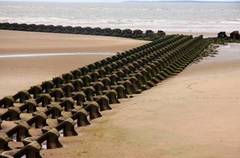 Erosion Reveals England’s World War Two Coastal Defences Aug 30, 2015 Erosion caused by weathering on England’s south coast is revealing some vital coastal defences from World War Two. A three mile stretch of the British coastline in the New Forest region, from the town of Barton on Sea to Milford on Sea has been exposed. The exposure comes as natural erosion occurs and it has revealed the vast expanse of World War Two defense lines put in place by the British military in anticipation of a possible land invasion by the Germans. The defenses include a large field of metal poles and concrete posts intertwined with rolls of barbed wire, alongside pill boxes, all emerging from the bottom of the seabed. After the war the defenses were abandoned and left to rot and become covered on the deep shoreline of the English Channel. Now that the defenses are becoming evident war enthusiasts, researchers and archaeologists are visiting the site to document and review the scene so that they can discover more about Britain’s land defense strategy. The coastal erosion is caused by sea storms lashing the coastline as well as the strength of the tides over the years. The defenses had been erected by the British Army’s Wiltshire Regiment in 1940 when the threat of a German land invasion was at its highest and the Blitz was taking place across the UK, The Telegraph reports. Because the defenses are so near to the shoreline, local authorities are warning swimmers and bathers to not venture into the sea at certain points on the beaches. The danger is at high tide when the defences can’t be seen by the naked eye since they are hidden underneath the sea. To provide even more warning, buoys have been anchored to some of the metal poles so that the area is clearly marked whether it is low or high tide. The local authorities have decided to remove much of the defenses during the next set of lowest tides, which will probably be at the end of August, and they will have access only for a short period of two hours at a time. Engineers at the site said that the poles had been installed in a lattice formation along the shoreline and the pill boxes were starting to collapse. They expect these kinds of defenses to continue being unearthed as erosion of the coastline is ongoing. A lot of the defenses were removed at the end of the war, but a lot was left to submerge under the waves. Five tonnes of materials have already been moved by authorities this year alone.  The WWII Plane That Could Have Won Germany the War Mar 3, 2014 This is a picture of the Bugatti 100P. It was almost complete in 1940, when the Italian designer, Bugatti, quit production of the aircraft.. Ettore Bugatti refused to show the aircraft and decided to hide it from the German military, by packing it into crates and putting it in a barn in the French countryside. The plane was never assigned for a mission and it never flew out of its hiding place. John Lawson is a 59-year-old Scottish engineer and former RAF engineer from Musselburgh, who owns a model making company in Nottingham and previously worked on the Vulcan bomber. He has started production of a working replica of the Bugatti 100P. The original plane would have had 2450 horsepower engines and a 27 ft wingspan. The recreation of the “Bugatti Veyron of the skies” is taking place in Oklahoma, where a team of experts, led by Lawson are constantly working to develop the replica of the most advanced planes of its time. The designers believe that, if the aircraft had flown, it would have reached 500mph. The record for speed at that time, had been set by a German Messerschmitt in 1939, at 469mph. Ettore Bugatti became a French citizen in between the war and was known to dislike the Nazis, whom he wanted to challenge to an aircraft race, known as the Coupe Deutsch. The French government was already aware of the construction of the plane, but because the designers were not able to finish it before the deadline, which was September 1939, the Bugatti 100P never entered the competition. When World War Two began, the designers decided to hide the plane, the Mail Online reports. Lawson said that the 500mph Bugatti 100P was 85 percent complete when the Second World War began. ‘If it had flown in 1940, it would have been a revolution. It was an incredible aeroplane and Louis de Monge, who worked on it with Ettore Bugatti, was a brilliant engineer,’ insisted Lawson. It is believed that the only person inside the Nazi party, who knew about the construction of the aircraft was Albert Speer, one of the Fuhrer’s ministers. Luckily, they never manage to get hold of the technology, as it could have destroyed the Spitfire and won Germany the Second World War. 70 years later, the plane was displayed in a United States museum, too fragile to ever be restored. 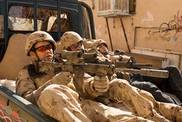 Paul Gross' New Movie to Benefit Wounded Warriors Director, actor and writer Paul Gross’ new film Hyena Road brings to life the struggles many Canadian soldiers faced while serving in Afghanistan. Translating that powerful onscreen message to real life, Gross has partnered with Wounded Warriors Canada to bring awareness to the organization and its work. “It’s such a terrific organization. They’re just so committed and most of what they do is really devoted to soldiers and families and I think they do tremendous work. A lot of our interest with the film is to bring awareness to what the Canadian Forces did over there and endured over in Afghanistan and they [Wounded Warriors] seem to really be the ones on the front lines to help with the aftermath of it all and it made sense that we would be partners with them. It’s a great organization,” said Gross. Portions of the proceeds raised from fundraising associated with the movie will be donated to the non-profit organization. Wounded Warriors supports Canadian Armed Forces (CAF) members who are ill and injured, primarily focusing on soldiers who have PTSD and operation injuries. Gross is hoping the movie will bring these issues to the forefront of audiences’ minds. “I think one of the most difficult things for an organization such as this is to make people aware of what we actually did there... If we can do anything we’ll at least bring a certain degree of authenticity and accuracy to capture the bewildering, chaotic nature of modern warfare and I think once people have a sense of that it will then make them understand why there are these ongoing problems associated with it. There are combat injuries that are physical and also psychological…I hope the film opens up a door onto what it was that they faced and then there’s Wounded Warriors saying here’s what we can do for those who have been damaged by it,” Gross said. Also in an effort to raise awareness, information booths for Wounded Warriors will be set up in select theatres across the country, public service announcements will be in trailers and Wounded Warriors will be recognized in the movie before the credits roll. All in an effort to “broaden the base of awareness for what Wounded Warriors is trying to accomplish,” as Gross puts it. Wounded Warriors is looking forward to the partnership hoping it will help the Canadian public to understand the kind of traumas many soldiers experience while in Afghanistan. "Hyena Road is an important medium to foster a national discussion about Canada's significant military contribution in Afghanistan. The film will help raise awareness about operational stress injuries like PTSD and the need for program funding support," said Scott Maxwell, Wounded Warriors Canada Executive Director. Wounded Warriors is encouraging civilians to watch the movie so they can catch a glimpse of what life as a soldier might have been like for many in Afghanistan. According to Maxwell, many veterans who have seen the movie have expressed that it portrays the war in an authentic and powerful light. Hyena Road centres around three characters with three different journeys all leading to a common purpose while in Afghanistan. The film makes its world premiere at the Toronto International Film Festival on Monday Sep 14 in Toronto and debuts nationwide on Friday, Oct 9. Hidden Nazi Treasure Train A historically significant military train has been found in Poland. At this time it is not clear whether the train includes the Nazi carriages laden with gold as a treasure-hunting duo have claimed, local officials in Poland have said Wednesday. According to NBC News: “The city [of Walbrzych] is full of mysterious stories because of its history,” the town’s deputy mayor Zygmunt Nowaczyk told journalists at a press conference. “Now it is formal information — [we] have found something.” A local press officer has now confirmed that a train has been found in the mountains near Walbrzych, on the Polish border with the Czech Republic. In the aftermath of World War Two, there were rumors that the Nazis had stockpiled a massive hoard of gold onto a train and sent it off, away from the advancing Allied and Soviet troops that were about to occupy Germany. Last week it was revealed that two treasure hunters had discovered a mysterious, old train near the southern town of Walbrzych. A claim has been filed with the Polish Government, since in Poland treasure finders are allowed to keep 10 percent of the value of the find. The train is said to be around 500 feet long, is armored, has gun platforms, and contains precious metals. The rumors about the treasure train spread at the end of the war, when Soviet troops were advancing on the Polish city of Wroclaw. The Germans are said to have filled a train with treasure and gold and sent it west. Locals had seen the train heading into the mountainous region on the Polish and Czechoslovakian border and it hadn’t been seen since. Locals say there are two gold train stories in the area. One is said to be in the area of Walbrzych and the other is said to be under a mountain, but the area has never been fully excavated or researched and so the stories have never been proved. Historians say that the Nazis did dig tunnels in the mountain region where the train has been discovered, and was said to be the biggest construction project that the Nazis undertook during the war. The reason for the tunnels, however, has remained a mystery and no one knows why they were building them, or what ended up being sent or stored there. The lack of documentation about the region suggests that the Nazis wanted to keep it a secret. It is because of this mystery that many believe the train was sent there for safe-keeping and hiding from the Soviets and Allies, The Telegraph reports. The gold on the train may have come from the Nazis looting during the war, but many remain skeptical that even if they have discovered the train that the gold will still be in it. Defence Platforms - Conservative Party The Conservative Party’s platform on Defence includes:
– Increasing the size of Canada’s reserve force from 24,000 to 30,000, a promise originally announced in 2008. Defence Minister Jason Kenney outlined other party platforms/accomplishments, including the National Shipbuilding Procurement Strategy. “The Conservative government maintains a robust defence policy based on the Canada First Defence Strategy (CFDS), which we first unveiled in 2008,” Kenney writes. “Guided by that document, we are committed to defending Canadian sovereignty, providing our men and women in uniform with the equipment they need, and playing an active role in global security.” Canadian Military Education Centre Museum Chilliwack's Canadian Military Education Centre Museum (CMEC Museum), is to close on 14 September, 2015. The museum building on Petawawa Road, on the former military Base Chilliwack, within the Canada Education Park is now required for other occupants in the spring of 2016. Therefore, the old Clothing Stores building, which has been used by the museum, but is owned by Chilliwack's City CEPCO, will be vacated by CMEC by the end of October. The CMEC Museum regrets the loss of our exhibit location, and the circumstances for this decision, but the search for alternative suitable sites to exhibit the extensive CMEC military displays is ongoing. CMEC is a non- profit association of several scores of very enthusiastic, passionate collectors, restorers, re-enactors and military exhibitor members. With the support of CEPCO, the CMEC Museum has been provided with the former Base Clothing Stores building to exhibit their extensive displays of military vehicles, weapons and other military artifacts since 2008. During this seven plus years, the Museum has received more than 25,000 visitors to view the displays and for younger and really interested visitors there was always the opportunity to climb in and on several vehicles. The CMEC Museum has lived up to its motto of "Preserve, Honour and Educate" by also providing group and student tours year round, but especially in the Remembrance month period, with the emphasis on educating Canadians and honouring veterans and the role they have played in building our Canada! The CMEC Association will remain active and will attempt to provide museum displays where ever possible. The Web Site will also remain active Open Season on Drones Just how do you shoot down unmanned aerial vehicles? David Pugliese, Ottawa Citizen September 1, 2015 There has been some buzz about the Breaking Defense story out of the U.S., reporting that a U.S. Marine sniper has successfully shot down an unmanned aerial vehicle (seven-foot wingspan) during a recent military exercise. The shoot-down took place at this year’s Black Dart counter drone exercise in California. “The Marine sniper shot from a UH-1Y Huey,” Lt. Cdr. Ryan Leary, a Black Dart project officer for the Joint Integrated Air and Missile Defense Organization (JIAMDO), told Breaking Defense. It was considered the first recorded incident of an airborne U.S. Marine sniper taking out a drone with a rifle, the publication noted. Military personnel in a helicopter also used that aircraft’s machine-gun to destroy another UAV. There was also a recent report about a Serbian sniper, a volunteer with pro-Russian rebels fighting in Ukraine. He is reported to have disabled a Ukrainian Army UAV with sniper fire. Then of course there are the U.S. civilians who have been blasting away at drones. A Kentucky man was arrested last month on charges of criminal mischief and wanton endangerment for destroying a small UAV. The man said the drone was spying on his daughter. When it was in a hover he pumped three rounds from his shotgun into the aircraft, destroying it. A New Jersey man is now facing serious charges for his 2014 shoot-down of a UAV. Again, a shotgun was used. He fired at the aircraft five times, destroying it in flight. 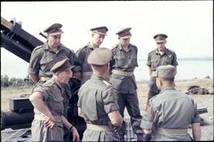 Who is it? Last Week: We didn’t get too many replies on this quiz but the picture was taken on 14 June, 1949 and there aren’t too many left from that time. One of the respondents is quite sure that the officer on the right is ‘Curley’ Pettis, who was a 3RCHA BC in the 60s. Another though the officer on the left is Gordon Platt but others disagree as this officer is older than Platt would have been. Some are sure that the NCO is George Chow but George himself doesn’t think it is him.  This Week: Our quiz this week continues our “gun” theme. It’s a rather easy one, for some of you, being as it is a gun mounted on a truck. So far, so good. Likewise, the next question: “What is the gun”, is now being scoffed at by some of the cognoscenti, while the other, related question: “What vehicle is that”, receives similar guffaws from many. Nonetheless, you are required to answer such in order to pass “Go”. The harder question is this: “What unit in British Columbia used this particular combination of khaki-coloured things?” The answer to this, I honestly don’t know, yet. However, I will know such by next week (I hope), thanks to the diligence and perspicuity of our many erudite readers. As an interesting, but rather useless aside, a similar combination of things was made by our Italian enemies (now NATO allies) during the Second World War. Kindly Commonwealth units, advancing away from the front line in the Western Desert, for reasons of economy, sometimes left similar vehicles for their future friends, who then mounted Breda guns on them, no doubt in a jocular salute to our lads’ generosity. If you have the answers, or educated guesses, please contact the editor, or the author, John Redmond ([email protected]). Thank you for playing the game. P.S. To see a similar gun, why not visit the Museum of the 15th Field Regiment (RCA) on a Wednesday morning? From the ‘Punitentary’ Why don't pigs use the telephone? Because there's crackling on the line. Murphy’s other Laws It’s bad luck to be superstitious. Quotable Quotes Fortune knocks but once, but misfortune has much more patience. Laurence J Peter CIC Vancouver and the Royal United Services Institute present a Panel Discussion Canada’s Foreign Policy and the Federal Election 2015 with Dr. James A. Boutilier Dr. Michael Byers Ms. Jill Stirk Following a LIVE SCREENING of the MUNK DEBATES | Date: Monday, September 28th, 2015 | Time: 3:30pm Early Registration 4:00pm Live Munk Debates Screening 5:30pm Panel Registration Refreshments and Cash Bar 6:30-7:30pm Panel Discussion | Location: Law Courts Inn, 5th Floor 800 Smithe Street, Vancouver, BC | Tickets: purchase online here | Three weeks prior to one of the closest federal elections in recent Canadian history, a moderated panel of experts will present their views on the implications of the election outcome for Canada’s foreign and defence policies. This panel will follow a live screening of the Munk Debates, held in Toronto. Foreign policy is often neglected during campaign time. The CIC Vancouver Branch is partnering with the Royal United Service Institute (RUSI) to promote public discussion in our collective mission to inform our local community with respect to international affairs. | This year’s election is proving to be a unique one for our nation. The leaders of the three major parties in Parliament have agreed to participate in the Munk Debates on Canadian Foreign Policy, currently scheduled to coincide with this event. Following the screening and refreshments, each of our speakers will provide expert commentary on foreign policy planks of the competing parties, along with informed speculation as to what foreign policy directions might emerge after the October 19th election. We urge members and non-members to attend and put questions to our excellent panelists.  MEET OUR PANELISTS Dr. James A. Boutilier Special Advisor, International Engagement Maritime Forces Pacific Headquarters Dr. James Boutilier is the Special Advisor, International Engagement at Maritime Forces Pacific Headquarters, Canada’s west coast naval formation, in Esquimalt, British Columbia. Dr. Boutilier attended Dalhousie University (BA History, 1960), McMaster University (MA History, 1962), and the University of London (PhD History, 1969). Dr. Boutilier has held posts at various universities throughout his career, including the University of the South Pacific in Suva, Fiji, Royal Roads Military College in Victoria, British Columbia and the University of Victoria. Dr. Boutilier’s field of expertise is Asia-Pacific defence and security. He published RCN in Retrospect in 1982 and has written extensively on maritime and security concerns. He lectures nationally and internationally on political, economic, and global security developments.  Dr. Michael Byers Canada Research Chair in Global Politics and International Law, University of British Columbia Michael Byers holds the Canada Research Chair in Global Politics and International Law at the University of British Columbia. He has been a Fellow of Jesus College, Oxford University, a Professor of Law at Duke University, and a Visiting Professor at the universities of Cape Town, Tel Aviv, Nordland (Norway) and Novosibirsk (Russia). Professor Byers is a regular contributor to the Globe and Mail and the National Post. His most recent book, International Law and the Arctic, won the 2013 Donner Prize for the best public policy book in Canada.  Ms. Jillian Stirk Former Ambassador to Norway, Head of the Afghanistan Inter-Department Committee; Assistant Deputy Minister for Europe and Africa in DFATD Jillian Stirk is a former Canadian ambassador and Public Service executive with more than thirty years experience in public policy, foreign affairs, international trade, and multinational negotiations. Until June 2013, Jillian was the Chief Foreign Policy Officer and Assistant Deputy Minister-Strategic Policy, Global Issues, and European Affairs at the Department of Foreign Affairs, International Trade, and Development. Jillian served as Canada’s Ambassador to Norway from 2005-2009. Jillian is a Dialogue Associate at the Simon Fraser University Centre for Dialogue and a Mentor with the Pierre Elliott Trudeau Foundation, where she is co-leading a project on Diversity, Pluralism and the Future of Citizenship. She currently sits on the Advisory Board of the Allam Advisory Group, a global trade consulting firm and she is also a member of the Board of Trustees of the West Vancouver Memorial Library. She volunteers with the Minerva Foundation for BC Women, and with several other academic and community organisations.  MEET OUR MODERATOR Cameron Cathart President, Royal United Services Institute (RUSI) of Vancouver Cameron Cathcart is a former broadcast journalist with a career spanning 40 years, including 30 years with the CBC as foreign correspondent in Washington, parliamentary reporter in Ottawa, national correspondent in Canada, executive producer, and on-air presenter for the CBC radio and television networks. Following early retirement Mr. Cathcart became an active volunteer. In July 2015 he was recognized by the City of Vancouver with the 2015 Civic Merit Award for his leadership of the annual Remembrance Day Service at Victory Square which has become one of the largest and most respected ceremonies of its kind in Canada In 2012 he received the Queen Elizabeth II Diamond Jubilee Medal for “dedicated service to his peers, the community and to Canada” and in 2009 was awarded the prestigious Minister of Veterans Affairs Commendation for promoting awareness of veteran’s issues in Canada. September 5, 2015 Dear Friends, The Chinese Canadian Military Museum is the only museum of its kind in Canada. Our goal is to collect, preserve, document, and celebrate the role of Chinese Canadian veterans in the service of Canada’s military. Our emphasis over the past 15 years had been on educating Canadians on the role Chinese Canadians played during the Second World War, and the double victory that was won as a result of their sacrifice. Not only did Chinese Canadians play a role in the victory of the Allies over fascism in 1945; they also improved the lives of all Chinese Canadians when, in 1947, the federal government finally granted the community full citizenship and the right to vote. Today, we have only a small number of Canadian veterans from this war still with us. Many are active in our museum. All are in their 90s. This year also marks the 70th anniversary of the end of the Second World War. It is a milestone year that we need to commemorate. Sadly, we recognize this is one of our last opportunities to honour as many of the few remaining World War II veterans still alive. To this end, our museum is hosting a 70th Anniversary Commemorative Gala dinner on Saturday, October 24, 2015 in Vancouver. This is the year, and the occasion, to really honour the veterans that are left by hosting the most amazing gala commemorative dinner for them with an outstanding, distinguished Canadian in attendance. To make this year truly special, we have invited Lieutenant General (Ret’d), the Honourable Romeo Dallaire and he has accepted to be our keynote speaker for the evening. He is a former soldier and Canadian senator. And he is a man who, due to his time in Rwanda as a peacekeeper, speaks passionately about conflict, resolution, compassion … and forgiveness. Although he is a high profile speaker, he does not take any money for himself. However, he does use his speaking fees to raise money for his humanitarian work – specifically his mission to end the use of child soldiers. All money goes to his foundation, and he is selective as to what speaking engagements he accepts. Your support by attending this dinner will help us to raise money not only for our museum but also for LGen Dallaire’s foundation. The museum is promoting this event to all the military regimental associations, Army, Navy and Air Force Veterans (ANAVETs) units, Royal Canadian Legions (RCL) branches and local militia units and reserves. We hope that you will join us at this momentous occasion to pay tribute to these war heroes. If you also wish to donate to the museum, we are able to issue tax receipts for your contribution to help us carry on with the stories and legacies of these veterans. Please use the attached form to order your tickets and do share this invitation to your family, friends and colleagues at work and clubs. I look forward to seeing you at the dinner. Thank you for your support of our veterans. Sincerely King Wan President Attach. 15th Field Artillery Regt Seeking Recruits
Primary Reserve Artillery Information Session Monday October 19th, 2015 @ 6:00 P.M and Monday October 26th, 2015 @ 6:00 P.M Those interested in applying to the Canadian Armed Forces Primary Reserves are welcome to attend a one-hour information session as a first step in the recruitment process. These sessions will include information on career availability, benefits, training, and more. Registration is mandatory for all information sessions 2025 West 11th Ave, Vancouver BC To register, call 604-666-4371 or email [email protected] Be sure to include the following information:· Your name and address Phone number (home, work, cell) Email address Date and time of presentation |
Archives
June 2024
|


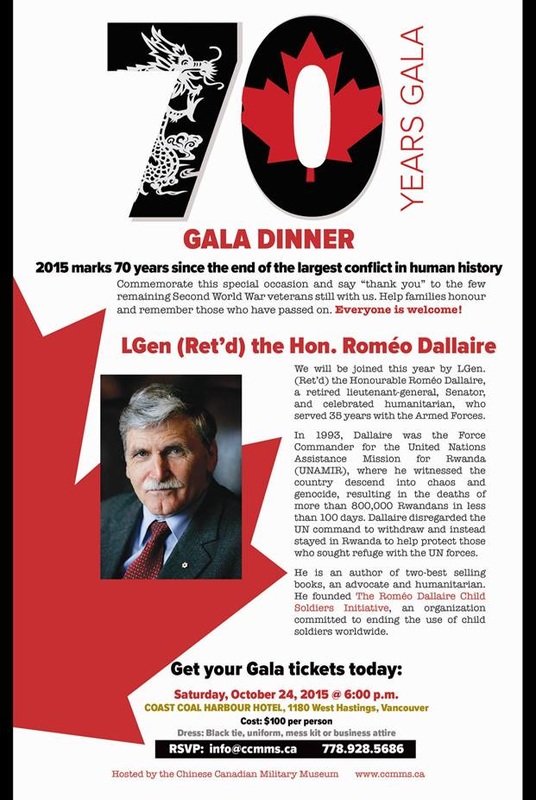
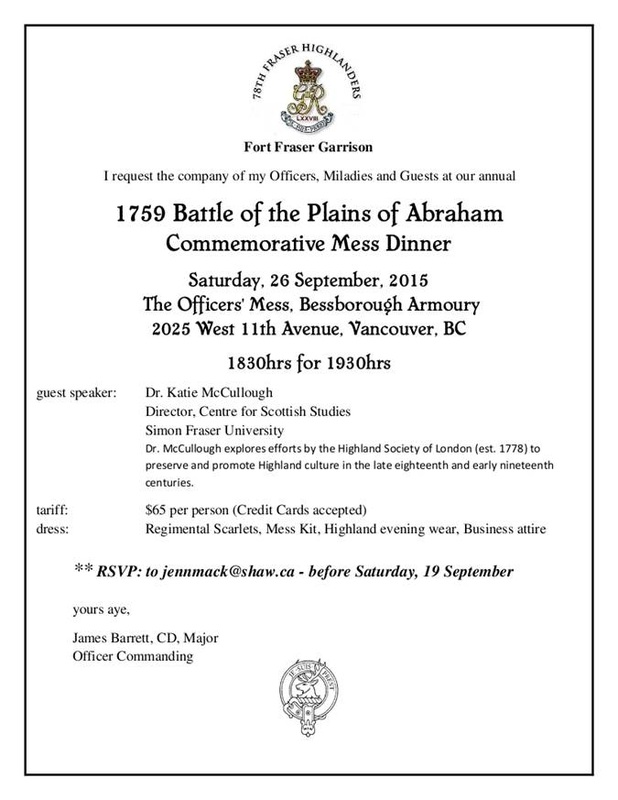

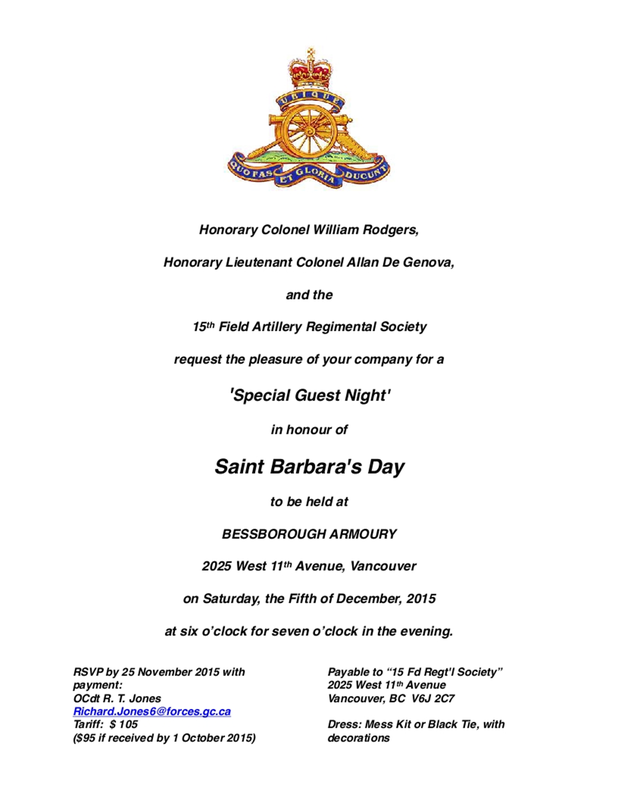
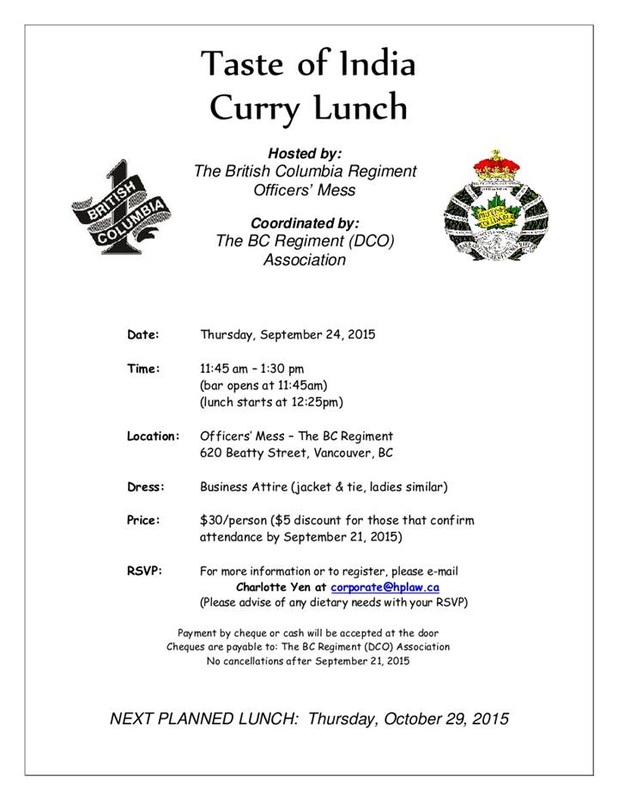
 RSS Feed
RSS Feed